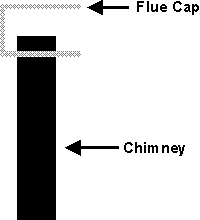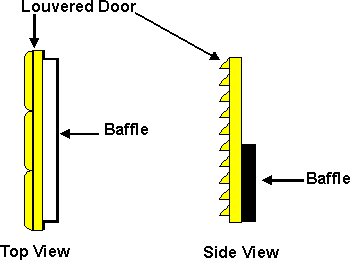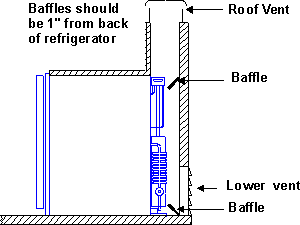Dave's Place
Flame Blow Out

Burner flame blow out while traveling can be one of the most frustrating problems there is to solve. You could put the same model of refrigerator into two different RVs, and one could have no blow out problem, while the other could have a constant problem. What we are concerned with here is blow out from a gust of wind, not a flame dropping out from an improperly working safety system.
The easiest way to solve a blow out problem is by installing an electronic igniter. This is cheating a bit, since you're not really solving the problem, but relighting the burner after it has blown out. There are universal kits sold for this purpose.
When attempting to solve a blow out problem, first go to the basics. Be sure you have a healthy burner flame, and also be sure all burner covers and shields are in place. The chimney on all cooling units should be topped off with a chimney extension or flue cap, see below. The chimney baffle also needs to be in place. These chimney parts coupled with good venting (which creates an up draft) will go a long ways in preventing a down draft through the chimney.
The refrigerator cabinet and the installation of the refrigerator itself should be sealed in such a way that air from the outside cannot enter the interior of the coach via the louvered access door or vent. The bottom of the refrigerator (interior edge) and holes for gas lines and other components passing through the cabinet are often left unsealed, but shouldn't be. Sealing the cabinet not only prevents drafts that can contribute to flame blow out, but also keeps cold drafts from bothering the occupants of the RV.
Before we cover some possible solutions, we need to cover one big "Don't". Do not block the flow of air up and through the cooling unit. See venting for proper chimney effect and proper air flow. One common, but not good, practice for solving a blow out problem is placing a furnace air filter over the louvered access door at the rear of the refrigerator. Don't. This can dramatically limit the air flow for the cooling unit and may eventually damage it.
The next step in solving a blow out problem is guess work. The aerodynamics of an RV going down the road can create some unforeseen and unwanted air currents that will blow out the flame. Even changing a trailer's tow vehicle can have an effect.

You may want to temporarily block off one of the refrigerator vents for testing in an attempt to isolate which vent the air currents are coming from. The key word here is "temporarily". Only block off a vent for twenty or thirty minutes while a refrigerator is in operation. Doing so for a longer period of time may damage the cooling unit. Once you have a theory as to where the air currents are coming from, you can try one of the baffling methods below in a trial and error process. Don't get carried away and try all the baffling methods at once. The ideal solution is just the right baffle(s) in just the right place, because although your intentions are to prevent a flame from blowing out, you're also tampering with the venting system for the refrigerator which could lead to more serious and costly problems with a bad cooling unit.
A baffle on the louvered access door at the rear of the refrigerator (above) should have at least a 1" clearance away from the door and should not cover more than half the door. Be careful not to block weep holes built into the bottom of the door frame, designed to allow propane to escape. Although the graphic to the right shows the baffle on the lower section of the door, it may work better at the top or in the middle.

Another baffling method is shown to the left. Although two baffles are shown in the graphic, only one may be necessary. Also, the positioning of the baffles is only tentative. Remember, this is a trial and error process.

Sometimes accessories added to the roof can change the air currents in such a way to cause a flame blow out problem. Be suspicious of this if your blow out problem began right after installing something new. The baffle in the graphic to the right should be as tall as the roof vent it is protecting.
RV Refrigerator Home
This RV refridgerator information was originally located on rvmobile.comRV Mobile Inc. 11715 HWY 99, Everett, WA 98204
The owner of RV Mobile Inc. apparently suffered a heart attack and the original website was shut down.
It has been reposted here to preserve this wealth of information RV refridgerator information.